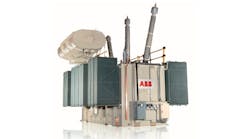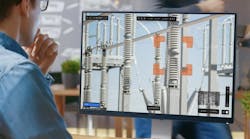The networks that transmit and distribute electrical energy are continually facing new demands due to changes in power generation and load structure. For example, in many regions power grids are undergoing gradual change, eg, adding generation, interconnecting local/regional grids, switching from overhead lines to high voltage cables for environmental reasons, and so forth. Such changes are usually made step-wise and are often followed by revised reactive power compensation requirements.
Further, the growing use of renewable energy sources is bringing fundamental change to traditional generation structures and is placing new demands on the transmission network. The dynamic and time varying effects associated with renewable sources play a more pronounced role in networks when the system is, as a whole, optimized for energy efficiency.
Another driver making variable reactors attractive is the emergence of smart grids. These are currently attracting a great deal of attention and are high on political and technical agendas.
It is not only the active power flow in a network that has to be controlled, but the balance of reactive power too. The most commonly used device for compensating reactive power and for maintaining voltage stability is the shunt reactor. By tradition, shunt reactors have fixed ratings with no regulation. If regulation is needed, then reactors are switched in and out along with load variations. This procedure, however, has disadvantages. The large steps in reactance lead to step changes in the system voltage level and more stress on breakers. Little dynamic regulation is provided.
The VSR is product that helps solve these power distribution network issues.
The VSR is a new product type that is rapidly becoming popular. It provides regulation capability and, thereby, system benefits in terms of power quality, optimized grid operation and the possibility of interacting with other regulating devices such as SVCs.
Reactive power compensation
The voltage along an alternating current (AC) transmission line depends on both the capacitive charging and the loading of the line. The former is due to the capacitance between the line's conductors and earth and depends on the line geometry. The capacitance generates so-called reactive power in the line. The reactive power is normally expressed in MVAr. The latter plays a role because both the loads and the line itself consume reactive power. In an AC system it is important to maintain the balance between the generated and the consumed reactive power. The reactive power balance determines the voltage stability of a transmission line, no matter whether it is an overhead or cable line. If there is an excessive amount of reactive power, the voltage will increase in the system. If there is a lack of reactive power, the voltage will decrease. Therefore, the reactive power must be controlled in order to maintain voltage stability.
Shunt reactors
A shunt reactor is an absorber of reactive power and is the device most commonly used for reactive power compensation. The shunt reactor can be directly connected to the power line or to a tertiary winding of a three-winding transformer.
The shunt reactor could be permanently connected or switched via a circuit breaker. To improve the adjustment of the consumed reactive power the reactor can also have a variable rating. If the load variation is slow, which it normally is (seasonal, daily or hourly) a VSR could be an economical solution for some customer applications.
The VSR in a power system
In some applications there is a need to connect or disconnect the inductive reactive power in steps. Then, several shunt reactor units are needed. This requires several circuit breakers and, consequently, a bigger footprint. Instead of having several units, one VSR that covers the entire power range could be a more cost-effective solution. By regulating the inductance of the reactor inside the unit itself, the external circuit breakers will have fewer operations and will, thus, need less maintenance.
Generally, it can be said that when there is a slow variation of the load, the VSR works as an efficient reactive power compensator and it enables a better fine tuning of the voltage in the system to be accomplished.
ABB gapped core shunt reactor
Most oil-immersed shunt reactors manufactured by ABB are based on the so-called gapped core concept. This technical concept is based on the core type technology that has been used within ABB since the beginning of the 1970s. More than 2,500 reactors based on this concept have been manufactured by ABB for the global market since then and hundreds of units have been in service for thirty years or more.
General design
The philosophy of the design is to minimize losses, sound and vibration. Design similarities with large power transformers permit an efficient use of ABB's long experience of building large transformers, for instance in the areas of insulation build up, production handling and so on. Each phase limb consists of a number of so-called core segments that are circular in shape. Between the segments there are non-magnetic gaps that contain oil and spacer elements. Due to the high magnetic reluctance, most of the energy of the reactor is stored in these gaps. In the case of a shunt reactor with a fixed power rating, there is only one physical winding around each phase limb. To minimize the size, and to avoid spreading of the electromagnetic flux, a magnetic core frame surrounds the phase limbs ➔ 1.
1 Gapped core concept for efficient use of active material
High voltage shunt reactors are technically complex products due to the large magnetic forces, which can be tens of tonnes, acting between the core segments. These forces appear 100 times per second in 50 Hz systems, so the engineering challenges with respect to longterm mechanical stability are considerable. This can be seen in the failure statistics of some utilities where there is wide spread in failure rates depending on the design of the reactors [1, 2].
To verify the mechanical integrity of the ABB shunt reactors, an extensive study was made in which sound measurements were made on reactors that have been in operation for between 5 and 23 years [3].
These measurements were compared with the original factory acceptance tests. The study shows no increase in sound levels over time, which is a very good indication of a mechanically robust design ➔ 2. The long-term stability in sound level can be explained by robust design, durable materials and precision in the manufacturing process.
2 Measured sound power levels of seven shunt reactors against year of manufacture: factory measurement (first column) and 2007 on-site measurement (second column)
VSR design
The main function of a VSR is to regulate the consumption of reactive power. This is accomplished by connecting and disconnecting electrical turns in the reactor by means of a tap changer. At the maximum power rating the minimum number of electrical turns will be connected.
3 The design principle of the active part of the VSR
The ABB VSR design is the result of extensive development work combined with well-proven power transformer and reactor technology ➔ 3. The regulation of the reactor is accomplished by a separate regulating winding, or windings, located outside the main winding. The taps from the regulating winding are led to the tap changer. The regulating winding configuration can vary depending on the regulating range, voltage level and loss capitalization 1.
The regulating range is limited by the maximum step voltage and voltage range of the tap changer. Another limitation is the electrical behavior of the regulating winding under transient voltage stresses. The feasible regulation range depends on the voltage rating of the reactor ➔ 4.
4 The feasible range is the area above the curve and the feasible voltages are 110 kV to 525 kV
Today, utilities are demanding a regulation range larger than that indicated in the figure. As a result of this market demand, the VSR concept has recently been further developed to provide regulation ranges that are around 40 percent higher. As an example, 420 kV VSRs with a maximum rating of 200 MVAr can today be regulated between 90 and 200 MVAr compared with the 120 to 200 MVAr range of a few years ago.
VSR field references
The main transmission line system in Norway has been upgraded from 300 kV to 420 kV. In the new 420 kV grid, the system operator has decided to only use VSRs instead of shunt reactor units with fixed power ratings. There are several benefits supporting this policy decision:
- Low short-circuit power. If the MVAr rating of the reactor is high compared to the short-circuit power of the network, the voltage will jump when the reactor is switched in or out. To minimize this phenomenon, it is possible to switch the unit in or out at a minimum-power tap position.
- There is only one variable reactor unit instead of two units with fixed power ratings. This minimizes footprint and the number of circuit breakers.
- The VSR is complementary to substation SVC equipment. This allows coarse tuning of the total reactive power compensation.
- Better fine tuning of the voltage to cope with seasonal and daily load variations is available.
- There is flexibility for future load conditions in the network.
The ratings of these VSR units are 80–150 MVAr at 300 kV, 120–200 MVAr (three-phase) at 420 kV and, recently, 90–200 MVAr at 420 kV.
Another example comes from a transmission company in the United States that began implementing inductive reactive power compensation with shunt reactors that are connected directly to the high voltage line. By now utilizing oil-immersed shunt reactors, they were also able to eliminate environmental concerns surrounding electromagnetic flux spread around open air core reactors.
This company chose the ABB VSR for inductive compensation control. The extensive use of AC cables in their network placed particularly high value on the ability to control reactive power compensation. A bonus is that the reduced number of circuit breaker operations results in less maintenance.
The rating of these VSR units is 50– 100 MVAr (three-phase) at 242 kV.
A final example is found in some African countries where relatively long transmission lines feed small load centers. The loads have a daily variation and there are also future plans to increase the load. That makes the ABB VSR a good solution for the owner of the transmission lines since it is essential to accommodate variability in the inductive reactive power compensation requirements. For these applications the size of the units has been up to 30 MVAr (three-phase) and voltage ratings of between 110 and 225 kV.
In total, ABB has received orders for 38 VSRs from five countries. ABB is the market leader for this application. The market interest for this product is constantly growing.
Claes Bengtsson
ABB Power Transformers
Ludvika, Sweden
[email protected]
------------------
References
[1] Petersen A. et al. (2007). Australian experience with shunt reactors – reliability, condition assessment, end of life and impact on specifications. Cigré A2/D1 Colloquium Bruges 2007, paper pp. 3–41.
[2] Cormack R. (2007). A snapshot into one utility's experience with the operation of shunt reactors. Cigré A2/D1 Colloquium Bruges 2007, keynote p.3.
[3] Bengtsson C. et al. (2008). Field Performance and Sound of Shunt Reactors in Service. Cigré 2008, paper A2-306.
[4] G. Bertagnolli et al. (1998). Design and application of variable Mvar output shunt reactors with on load tap-changer. Operation experience in Africa. CIGRE Sessions 1998, Paris, France, paper 12–308.
------------------
Footnote
1 "Loss capitalization" – based on expected energy prices, interest rates, etc., the customer puts a financial value on each kW of losses. This is added to the price of the reactor to form a comparison price which is used for evaluating tenders.






